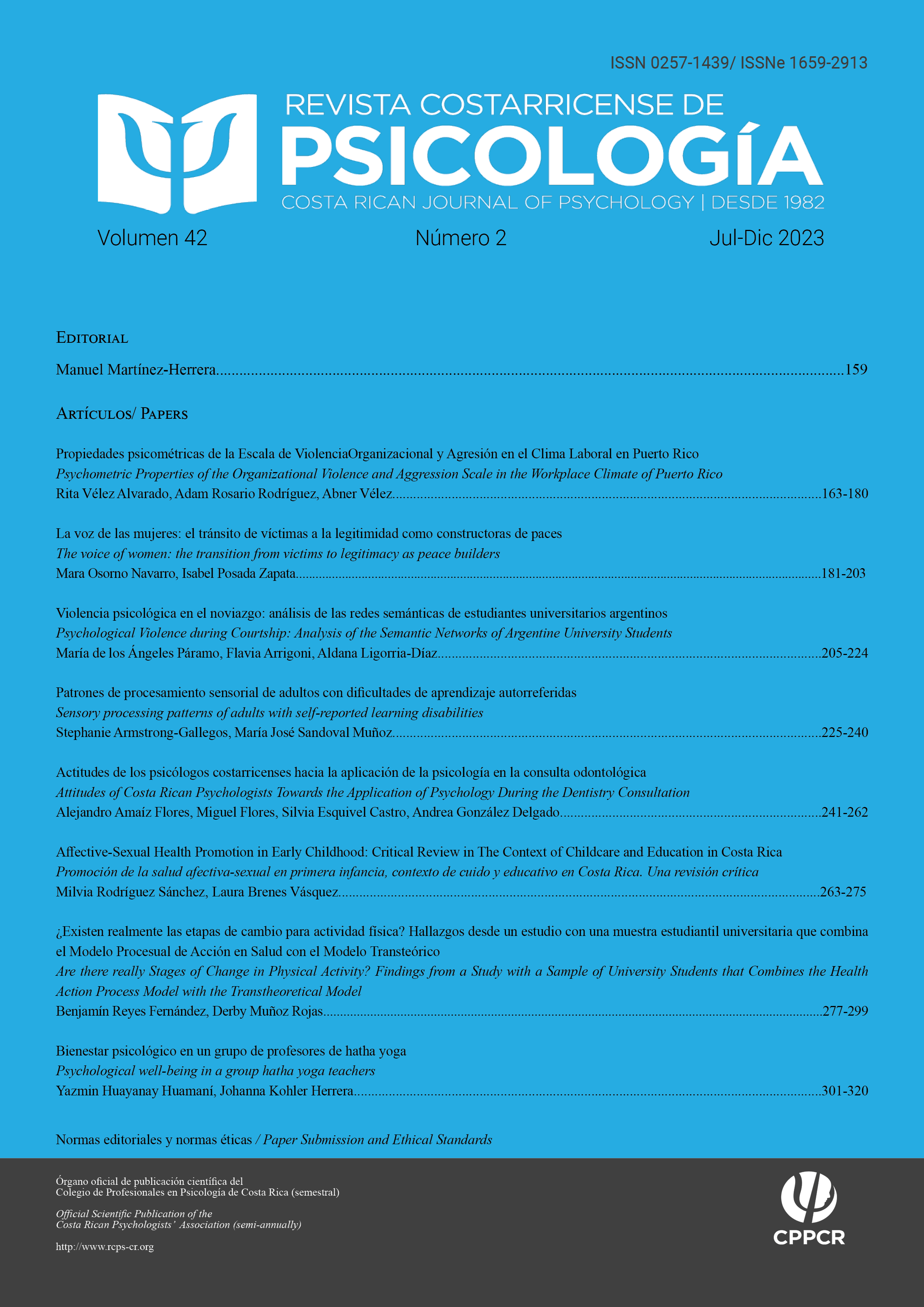Psychometric Properties of the Organizational Violence and Aggression Scale in the Workplace Climate of Puerto Rico
DOI:
https://doi.org/10.22544/rcps.v42i02.01Keywords:
Organizational Violence, Physical Aggression, Psychological AggressionAbstract
Violence in the workplace refers to threatening or violent action against an employee. The purpose of this study was to analyze the psychometric properties of the Organizational Violence and Aggression in the Workplace Climate Scale (EVOACL) Kessler et al. (2008) in a sample of Puerto Rican adults. A total of 204 workers participated in this exploratory, instrumental and psychometric study. The results showed a Three-factor solution as the most appropriate to explain the variance in the scores. These factors identified as Policies and Procedures, Procedures and Response, and Imposition of Unsafe Practices. A total of 18 items met the criteria of discrimination and appropriate factor loads (six items per factor.) The reliability index of the scale was .96 (Cronbach’s alpha) for the dimensions of the Policies and Procedures and Procedures and Responses and .92 (Cronbach’s alpha) for the dimension of the Imposition of Unsafe Practices. These results suggest that the EVOACL has the potential to measure this construct in the Puerto Rican work environment. Also, EVOACL will allow the advance of new research on the phenomenon of Organizational Violence and Aggression in the Workplace Climate in the working population of Puerto Rico.References
Aish, A. M., & Jöreskog, K. G. (1990). A panel model for political efficacy and responsiveness: An application of LISREL 7 with weighted least squares. Quality and Quantity, 24, 405-426. https://doi.org/10.1007/BF00152013
Brislin, R. W. (1970). Back-translation for cross-cultural research. Journal of Cross-Cultural Psychology, 1(3),185-216. https://journals.sagepub.com/doi/10.1177/135910457000100301
Brislin, R. W. (1986). The wording and translation of research instruments. Sage Publications.
Butera, V. (2016). Cal/OSHA proposes extensive regulations to address workplace violence health care settings--will Federal OSHA follow suit? Employee Relations Law Journal, 42(2), 47-49.
Departamento del Trabajo y Recursos Humanos del Gobierno de Puerto Rico. (2016). Violencia en el lugar de trabajo. http://www.trabajo.pr.gov/prosha/download/PROSHA_029_Violencia_Lugar_Trabajo.pdf
El Martillo de Suarez (2019, agosto 11). El acoso laboral en Puerto Rico. https://suarezepr68.wordpress.com/2019/08/11/el-acoso-laboral-en-puerto-rico/
Fornell, C., & Larcker, D. F. (1981). Evaluating structural equation models with unobservable variables and measurement error. Journal of Marketing Research, 18(2), 39-50. https://doi.org/10.2307/3151312
Hernández, R., Fernández, C., & Batista, P. (2014). Metodología de la investigación (6ta ed.). McGraw Hill.
Jaramillo, V. A. (2008). Salud laboral: Investigaciones realizadas en Colombia. Pensamiento Psicológico, 4(10), 9-25. https://revistas.javerianacali.edu.co/index.php/pensamientopsicologico/article/view/701
Kessler, S. R., Spector, P. E., Chang, C., & Parr, A. D. (2008). Organizational violence and aggression: Development of the three-factor Violence Climate Survey. Work & Stress, 22(2), 108-124. https://www.tandfonline.com/doi/abs/10.1080/02678370802187926
Martínez-Isasi, S., García-Zurita, A., Felipez-Agrelo, I., & Castro Dios, D. J. (2015). Violencia sufrida y percibida por el personal de enfermería del área sanitaria integrada de A Coruña / Suffered and perceived violence by nurses integrated health district A Coruña. Enfermería Global, 14(3), 219-229. http://revistas.um.es/eglobal/article/view/198231
Martinko, M. J., & Zellars, K. L. (1996). Toward a theory of workplace violence: A social learning and attributional perspective. Academy of Management Best Papers Proceedings, (1), 419-423. https://doi.org/10.5465/ambpp.1996.4981037
Mensah-Boafo, I. (2016). “...they think we are conversing, so we don’t care about them...” Examining the causes of workplace violence against nurses in Ghana. BMC Nursing, 15, 1-8. https://bmcnurs.biomedcentral.com/articles/10.1186/s12912-016-0189-8
Merchant, J. A., & Lundell, J. A. (2001). Workplace Violence Intervention Research Workshop, April 5-7, 2000, Washington, DC. Background, rationale, and summary. American Journal of Preventive Medicine, 20(2), 135-140. https://www.ncbi.nlm.nih.gov/pubmed/11165456
Organización Internacional del Trabajo. (2003). Repertorio de recomendaciones prácticas sobre la violencia en el lugar de trabajo en el sector de los servicios y medidas para combatirla. http://www.ilo.org/wcmsp5/groups/public/---ed_protect/---protrav/---safework/documents/normativeinstrument/wcms_112578.pdf
Pawlett, W. (2013). Violence, society and radical theory: Bataille, baudrillard and contemporary society. Routledg.
Satorra, A., & Bentler, P. M. (2001). A scaled difference chi-square test statistic for moment structure analysis. Psychometrika, 66(4), 507-514. https://doi.org/10.1007/BF02296192
Schumacker, R. E., & Lomax, R. G. (2010). A beginner’s guide to structural equation modeling (3rd ed.). Erlbaum.
Spector, P. E., Yang, L., & Zhou, Z. E. (2015). A longitudinal investigation of the role of violence prevention climate in exposure to workplace physical violence and verbal abuse. Work & Stress, 29(4), 325-340. https://www.tandfonline.com/doi/abs/10.1080/02678373.2015.1076537
Spector, P. E., Zhou, Z. E., & Che, X. X. (2014). Nurse exposure to physical and nonphysical violence, bullying, and sexual harassment: a quantitative review. International Journal of Nursing Studies, 51(1), 72-84. https://www.ncbi.nlm.nih.gov/pubmed/23433725
Tabachnik, B., & Fidell, L. (2013). Using multivariate statistics (6th ed.). Pearson.
The Workplace Bullying Alliance. (2015). Acoso laboral: Mal silente en el país. http://www.shrmpr.org/wpcontent/uploads/2013/08/Acoso-Laboral-Mal-silente-en-el-Pa%C3%ADs.pdf
Undie, C.-C., Maternowska, M. C., Mak’anyengo, M., & Askew, I. (2016). Is Routine Screening for Intimate Partner Violence Feasible in Public Health Care Settings in Kenya? Journal of Interpersonal Violence, 31(2), 282-301. https://doi.org/10.1177/0886260514555724
Weiner, B. (1985). An attributional theory of achievement motivation and emotion. Psychology Review, 92, 548-573. https://link.springer.com/chapter/10.1007/978-1-4612-4948-1_6
Published
How to Cite
Issue
Section
License
Copyright (c) 2023 Costa Rican Journal of Psychology

This work is licensed under a Creative Commons Attribution-NonCommercial-NoDerivatives 4.0 International License.
El Colegio, como institución editora, tiene todos los derechos reservados (copyright) sobre lo que se publica en la revista. Los autores y las autoras firman una declaración de cesión de derechos de autoría en el caso de aceptación de sus manuscritos para publicación en la revista, conforme con lo establecido en la legislación vigente.
Los artículos publicados representarán el punto de vista de su autoría y no de la revista, por lo que la autoría asume responsabilidad ante cualquier litigio o reclamación relacionada con derechos de propiedad intelectual y exonera de cualquier responsabilidad a la Revista Costarricense de Psicología y al Colegio.
La revista publicará en cada edición su política de acceso abierto (p.ej., Creative Commons). El material publicado en la revista puede ser copiado, fotocopiado, duplicado y compartido siempre y cuando sea expresamente atribuido al Colegio. El material de la revista no puede ser usado para fines comerciales.







